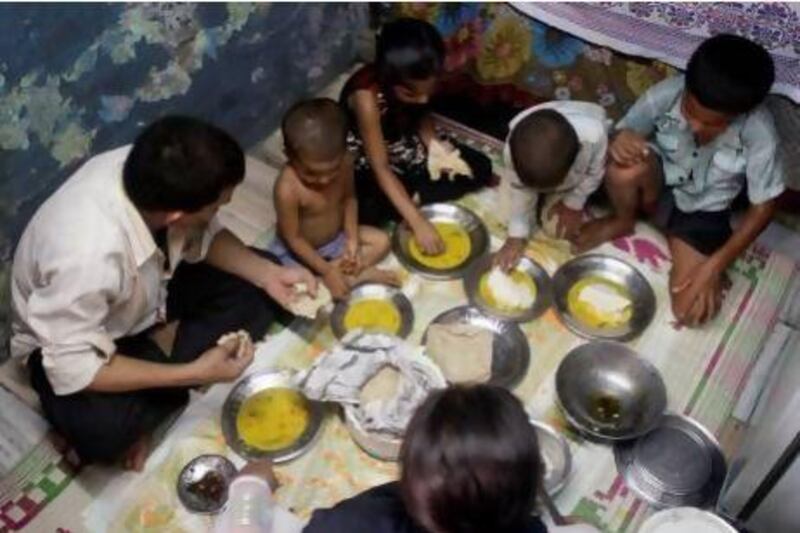Data released last month by the planning commission in India, which has come under much debate and questioning, suggests that the number of Indians living in poverty fell from 37 per cent in 2004-05 to 22 per cent last year.
The poverty levels it used are estimated at 816 rupees (Dh49) per person each month in rural areas and 1,000 rupees in urban areas, based on consumption expenditure. This methodology has attracted widespread criticism and is under review by a committee appointed by the planning commission.
The MPs Raj Babbar and Rasheed Masood created a stir when, following the release of the figures, they respectively said that a full meal would cost 12 rupees in Mumbai and 5 rupees in Delhi, comments for which they later apologised.
"The official poverty studies undertaken by the national statistical organisation has pointed to 138 million people being raised from dire poverty levels and that, too, in a decade," said Kamal Sen, the president and chief executive of Cogitaas, a consultancy specialising in strategy and planning.
"While the level is being debated, it is important since it at least defines dire poverty or a level that defines minimum food requirements. Studies have also shown that rural wages have risen the fastest in the last decade and it has risen faster than the rate of inflation. Given that inflation rates were high, in double digits, and that two thirds of the labour force works in agriculture, this has also had a significant impact."
Mr Sen believes there has been some trickle-down effect from the sharp economic growth India has undergone in recent years, although many argue the gap between the rich and poor is getting wider.
"Consumption levels, available from statewide data, show that consumption levels have gone up all across India including very rural states with high levels of poverty," Mr Sen said. "Since India's real GDP has doubled this century, it is most likely that the gains would be widespread at least to some extent."
With inflation levels soaring, however, many poor Indians complain their limited funds are not stretching as far. The fact that the rupee has tumbled to record lows drives up the cost of imports, which in turn fuels inflation.
"Inflation can be the biggest problem for low-income groups - and can push some of them back below the poverty line," said Raju Bhinge, the chief executive of Tata Strategic Management Group. "Hence controlling inflation to within 5 per cent per year is a priority. This necessitates reduction of the fiscal deficit and the current account deficit and a stable exchange rate."
Government funds could help, if used effectively, he says.
"Improvement in the effectiveness of spending on social programmes will create greater impact with the same funding," said Mr Bhinge. "The emphasis should shift to outcomes and impact instead of outlays and budgets, especially in programmes for health care, education and food distribution.
"Most government-run social programmes in India have the problem of improper targeting and significant leakages. The result is that the benefits often do not reach the truly needy."
The majority of India's poor are located in rural areas, where development is much needed.
"Development of rural infrastructure can improve incomes and create new livelihoods," according to Mr Bhinge. "Investment in rural roads, irrigation, energy supply, water conservation, affordable housing and sanitation coupled with improved agricultural practices can lead to growing output and employment and reduce poverty in rural areas."
The International Fund for Agricultural Development (Ifad) said the livelihoods of Indians in rural areas were often influenced by nature as well as by economic and social conditions.
"Large numbers of India's poorest people live in the country's semi-arid tropical region. In this area shortages of water and recurrent droughts impede the transformation of agriculture," according to Ifad. "There is also a high incidence of poverty in flood-prone areas such as those extending from eastern Uttar Pradesh to the Assam plains, and especially in northern Bihar," it added.
"Poverty affects tribal people in forest areas, where loss of entitlement to resources has made them even poorer. In coastal fishing communities people's living conditions are deteriorating because of environmental degradation, stock depletion and vulnerability to natural disasters."
V Laxmikanth is the managing director of Broadridge India, a technology-based outsourcing firm for the financial services sector. He said the rise of the services sector had helped to improve living conditions, as it enabled the country to become less dependent on agriculture.
"The multiplier effect is extremely important in terms of both job creation and the growth of the economy," he said.





